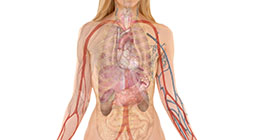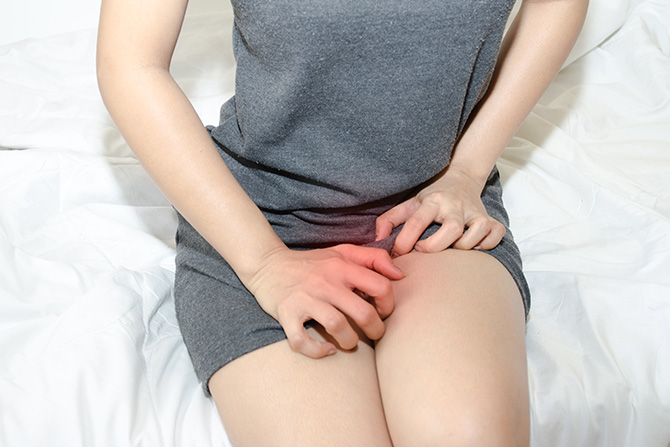Overview
Symptoms
Causes
Prescription
Health Tips
Seventy-five percent of women will experience at least one vaginal yeast infection during their lives; forty percent will have more than one infection, and five percent will have four or more infections in a year. Yeast infections are more common in women of childbearing age and pregnant women; however, it may occur in prepubescent girls and postmenopausal women.
Although there are a variety of species of Candida fungus, studies show that 90 percent of vaginal yeast infections are caused by Candida albicans, fungi (or yeast) that normally exists in the intestines, throat, mouth and vagina in small numbers. Changes in the internal environment cause the fungus to proliferate, wreaking havoc on various body systems. The fungi produce hormone-like substances that resemble human hormones, and some types have their own hormone receptors. The immune system often produces antibodies against Candida, causing an allergic response to an organism that normally exists in the body.
Symptoms
Vaginal yeast infections share some symptoms with trichomoniasis, a very common sexually transmitted infection. A doctor should be consulted to rule out a sexually transmitted infection (STI) for sexually active women who are experiencing a yeast infection that is not responding to treatment.
Common symptoms include:
- Cheesy white discharge with a distinct odour
- Painful intercourse with a burning sensation
- Skin of the vulva may be raw, red and dry
- Symptoms often worsen the week before or after menstruation
- Urination may be painful
- Vaginal itching and irritation
Causes
The human body contains microorganisms that live in delicate balance with one another. The beneficial bacteria normally keep Candida in check. Candida overgrowth often occurs opportunistically when the balance is upset, and beneficial bacteria become outnumbered, leading to a Candida yeast infection. Other factors may also trigger an imbalance; for example, antibiotics used to treat a bacterial infection also kills the beneficial bacteria responsible for keeping the pH of the vagina slightly acidic. This drop in acidity then allows the yeast to grow.
Hormonal changes (rising estrogen levels) that occur during pregnancy, before periods and during menopause may also cause yeast infections. This is because estrogen promotes the growth of Candida, and it is also why the birth control pill and hormone replacement therapy may cause an increased occurrence of yeast infections.
High blood sugar levels in the body may lead to increased levels of sugar in urine, mucous and sweat. Sugar becomes a fuel source for yeast living in the vagina. Women with type 1 and type 2 diabetes are at increased risk of yeast infections. Properly monitoring diabetes will reduce the chances of yeast infections.
Semen may contribute to acid imbalance sometimes. As mentioned, the vagina is slightly acidic, which keeps bacteria and yeast at normal levels and prevents infections. Semen is naturally alkaline which helps to buffer the acidic vagina and protect the sperm. Unfortunately, semen may also throw off the pH balance of the vagina and allow yeast to grow. Urinating after intercourse may help prevent infection.
Condoms may also affect vaginal flora in women sensitive to latex or nonoxynol-9, a lubricant/spermicide often used on condoms. Non-latex and nonoxynol-9-free condom options are available.
A genetic component has been found in some women who experience recurring or chronic yeast infections. In these women the immune system does not respond as it should to an overgrowth of Candida. However, not all women who have recurring or chronic yeast infections are genetically predisposed.
Stubborn infections may be due to a rare strain. The usual medications for yeast infections (fluconazole/miconazole) may not work as well on species such as Candida glabrata, Candida tropicalis, or Candida guilliermondii.
Other factors that may trigger a yeast infection are:
- Drinking chlorinated water
- Glycerin-based lubricants in women who are prone to infection
- Oral sex
- Pads, panty liners, tampons, soaps or douching
- Poor nutrition with a diet high in sugar
- Smoking
- Steroid medications
- Stress
- Weakened immune system
Prescription for Health
Pregnant women should consult a naturopathic doctor for treatment of Candida overgrowth.
Diet
Eat plenty of fruits and vegetables, about 7 to 10 half-cup servings daily. Legumes, fish, whole grains, nuts, seeds and their oils will provide the body with balanced nutrition. Avoid eating simple carbohydrates such as white bread, cake, cookies and chips, or too many citrus fruits which create an alkaline environment in the body and allow Candida to flourish.
Eat plenty of plain, whole milk, probiotic-rich yogurt (look for the words acidophilus or bifidus or bifidobacterium) to increase the population of good bacteria in the intestines. Just half a cup to one cup every day is enough to ward off yeast infections and restore balance to the body. When taking antibiotics, always supplement with probiotics.
If Candida is a reoccurring problem, switch to a diet that excludes all yeast and sugar (that means fruit, too). Any food that has been aged or fermented should also be eliminated including cheese, soy sauce, pickles, raw mushrooms, vinegar or alcohol, to name a few. Avoid gluten and eat millet, quinoa, amaranth and brown rice instead.
Start a diet diary and write down everything eaten to see if there is any correlation to allergy symptoms. Ask for a physician referral to an allergy specialist and get tested for possible triggers. Some allergies may only be detected with the help of an ELISA test. Once allergens are determined avoid those allergens. Get tested for environmental allergens as well.
Lifestyle
Reduce exposure to chemicals, perfumes, dyes, fragrances and scents. When fighting an infection, don’t use bubble bath, douches, perfumed toilet paper, or deodorized tampons. Avoid hot showers and baths and use unscented natural soaps.
Avoid tight and synthetic clothing during an infection and opt for loose breathable cotton instead. Change wet or sweaty clothing as soon as possible. Warm and damp environments promote yeast growth.
| Nutrient | Dosage | Action |
|---|---|---|
| Lactobacillus rhamnosus and Lactobacillus reuteri | 2 capsules daily, containing a total of 5 billion active cells | Restores urogenital flora; halts Candida overgrowth. Treats bacterial vaginosis when taken with antibiotics |
| Vitamin K2 MK7 | 100 mcg daily | Restores imbalance caused by antibiotics |
| Caprylic Acid (enteric coated) |
1–2 grams daily with meals | Acts as an antifungal |
| Oil of Oregano | 3 drops 3 times daily in juice or water | Powerful anti-fungal |
| Tea Tree Oil (must be diluted before application, mix with topical anti-fungals) |
local application 40% solution for a maximum of 5 days | Effective for Candida vaginitis
Do not apply to broken skin; if irritation occurs, discontinue |
| Berberine (containing herbs including Goldenseal and Oregon Grape) | Use as directed; make sure berberine content is listed on label | Acts as an antifungal |
| Garlic | 1000 mg daily | Natural antifungal |
| Lactoferrin | 500 mg 3 times daily | Antifungal action against candida albicans possesses broad-spectrum antibacterial, antifungal properties |
Health Tips for Healing
- After going to the toilet, wipe front to back to avoid spreading any fungus back to the vagina.
- Avoid taking oral contraceptives or steroid medications.
- Best protection from Candida is to enhance immune function through lifestyle, diet and supplements.
- Change undergarments daily and wash them at high water temperatures.
- Choose organic dairy products to avoid hormones and xenoestrogens.
- Consult a physician or naturopath if struggling with chronic or reoccurring vaginal yeast infections in a single year.
- Do not overeat; it suppresses the immune system.
- Drink plenty of pure, filtered water daily. For every alcoholic beverage consumed drink another glass of water.
- Eat plenty of plain probiotic-rich yogurt.
- For a recurrent Candida problem, switch to a diet that excludes all yeast and sugar.
- Get 7 to 8 hours of sleep each night.
- Infections in the vagina are not always yeast problems. Be tested to rule out bacterial vaginosis and sexually transmitted diseases.
- Mercury toxicity can make the body vulnerable to yeast overgrowth. Have hair, urine and blood analyses done to determine if this could be a factor. If so, avoid exposure to all mercury and have mercury-based dental amalgams removed.
- Sexual transmission is being investigated as a potential cause of yeast infections, but more research is needed to be conclusive.
- Stop smoking.
- Take one or two digestive enzymes before every meal. Do not drink fluids while eating as this will dilute enzymes.
- Take warm baths instead of hot showers. Dry off very well.
- Wear loose, cotton underwear instead of synthetic; do not wear panty liners.











